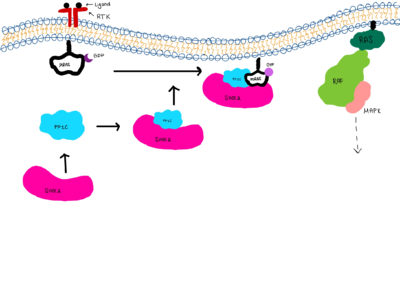Enolase
From Proteopedia
(Difference between revisions)
| Line 10: | Line 10: | ||
==Mechanism== | ==Mechanism== | ||
[[Image:mechanism.png|left|400px|The mechanism of 2PG to PEP using enolase.]]<ref>{{website2}}</ref> | [[Image:mechanism.png|left|400px|The mechanism of 2PG to PEP using enolase.]]<ref>{{website2}}</ref> | ||
| - | The | + | The <scene name='Cory_Tiedeman_Sandbox_1/Active_site/1'>active site</scene> of enolase as shown, involves Lys 345, Lys 396, Glu 168, Glu 211, and His 159. Enolase forms a complex with two |
| - | <scene name='Cory_Tiedeman_Sandbox_1/Active_site/1'>active site</scene> of enolase as shown, involves Lys 345, Lys 396, Glu 168, Glu 211, and His 159. Enolase forms a complex with two | + | |
<scene name='Cory_Tiedeman_Sandbox_1/Mg/3'>Mg 2+'s</scene> at its active site. | <scene name='Cory_Tiedeman_Sandbox_1/Mg/3'>Mg 2+'s</scene> at its active site. | ||
The substrate, 2PG, binds to the two <scene name='Cory_Tiedeman_Sandbox_1/Mechanism/4'>Mg2+'s, Glu 211, and Lys 345</scene>. The Mg 2+ then forms a bond at the deprotonated carboxylic acid on the 1'C to connect it with enolase. It also is connects to Glu 211 and Lys 345. Glu 211 makes a hydrogen bond with the alcohol group on the 3'C. Lys 345 deprotonates the 2'C and then the 2'C forms an alkene with the 1'C which then moves the electrons forming the ketone onto the oxygen making it have a negative charge. The other oxygen, which already has a negative charge, then moves its electron to form a ketone with the 1'C. The electrons that made up the alkene between the 1'C adn 2'C then moves to form an alkene between the 2'C and 3'C. This breaks the bond with the alcohol on the 3'C which deprotonates Glu 211 on enolase to form H2O. Then the new molecule is released from enolase as PEP. PEP then goes on through another step in glycolysis to create pyruvate. | The substrate, 2PG, binds to the two <scene name='Cory_Tiedeman_Sandbox_1/Mechanism/4'>Mg2+'s, Glu 211, and Lys 345</scene>. The Mg 2+ then forms a bond at the deprotonated carboxylic acid on the 1'C to connect it with enolase. It also is connects to Glu 211 and Lys 345. Glu 211 makes a hydrogen bond with the alcohol group on the 3'C. Lys 345 deprotonates the 2'C and then the 2'C forms an alkene with the 1'C which then moves the electrons forming the ketone onto the oxygen making it have a negative charge. The other oxygen, which already has a negative charge, then moves its electron to form a ketone with the 1'C. The electrons that made up the alkene between the 1'C adn 2'C then moves to form an alkene between the 2'C and 3'C. This breaks the bond with the alcohol on the 3'C which deprotonates Glu 211 on enolase to form H2O. Then the new molecule is released from enolase as PEP. PEP then goes on through another step in glycolysis to create pyruvate. | ||
Revision as of 09:41, 11 September 2022
| |||||||||||
Additional Resources
For additional information, see: Carbohydrate Metabolism
References
- ↑ Voet, Donald, Judith G. Voet, and Charlotte W. Pratt. Fundamentals of Biochemistry: Life at the Molecular Level. 3rd ed. Hoboken, NJ: John Wiley & Sons, Inc., 2008.
- ↑ Voet, Donald, Judith G. Voet, and Charlotte W. Pratt. Fundamentals of Biochemistry: Life at the Molecular Level. 3rd ed. Hoboken, NJ: John Wiley & Sons, Inc., 2008.
- ↑ Pancholi, V. "Multifunctional a-Enolase: Its Role in Diseases." CMLS, Cellular and Molecular Life Sciences 58 (2001): 902-20.
- ↑ The scop authors. Structural Classification of Proteins. “Protein: Enolase from Baker's yeast (Saccharomyces cerevisiae). 2009. 2/26 2010. [<http://scop.mrc-lmb.cam.ac.uk/scop/data/scop.b.d.b.bc.b.b.html>.]
- ↑ The scop authors. Structural Classification of Proteins. “Protein: Enolase from Baker's yeast (Saccharomyces cerevisiae). 2009. 2/26 2010. [<http://scop.mrc-lmb.cam.ac.uk/scop/data/scop.b.d.b.bc.b.b.html>.]
- ↑ Nguyen, Tram, and Katelyn Thompson. "Mechanism of Enolase Converting 2-Phosphoglycerate to Phosphoenolpyruvate." ChemDraw 10.0: Public Domain, 2008. [1].
- ↑ Voet, Donald, Judith G. Voet, and Charlotte W. Pratt. Fundamentals of Biochemistry: Life at the Molecular Level. 3rd ed. Hoboken, NJ: John Wiley & Sons, Inc., 2008.
- ↑ Westhead, E. W., and BO G. Malmstrom. "The Chemical Kinetics of the Enolase Reaction with Special References to the Use of Mixed Solvents." The Journal of Biological Chemistry 228 (1957): 655-71.
- ↑ Westhead, E. W., and BO G. Malmstrom. "The Chemical Kinetics of the Enolase Reaction with Special References to the Use of Mixed Solvents." The Journal of Biological Chemistry 228 (1957): 655-71.
- ↑ Pancholi, V. "Multifunctional a-Enolase: Its Role in Diseases." CMLS, Cellular and Molecular Life Sciences 58 (2001): 902-20.
Proteopedia Page Contributors and Editors (what is this?)
Michal Harel, David Canner, Alexander Berchansky, Jaime Prilusky, Cory Tiedeman, Joel L. Sussman

![V vs. [PGA]; PGA is 2PG, the top curve has [Mg2+] of 10^-3 M and the bottom curve has [Mg2+] of 106-2 M](/wiki/images/thumb/1/10/Enolase_kinetics.jpeg/200px-Enolase_kinetics.jpeg)
